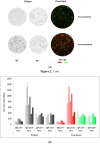Comparison of ELISpot and FluoroSpot in the Analysis of Swine Flu-Specific IgG and IgA Secretion by in Vivo Activated Human B Cells
- PMID: 24710411
- PMCID: PMC3901096
- DOI: 10.3390/cells1020027
Comparison of ELISpot and FluoroSpot in the Analysis of Swine Flu-Specific IgG and IgA Secretion by in Vivo Activated Human B Cells
Abstract
We have evaluated a novel B-cell FluoroSpot assay for the analysis of antibody responses in healthy individuals vaccinated intramuscularly with Influenza A (H1N1) antigen (Pandemrix®, GlaxoSmithKline). Using the FluoroSpot assay and an ELISpot assay run in parallel for comparison, we measured the frequency of cells secreting antigen-specific as well as total IgG or IgA antibodies seven days post vaccination. The assays were based on high affinity monoclonal antibodies for capture and detection of human IgG and IgA. Whereas conventional ELISpot analyzes IgG- and IgA-secreting B cells separately, fluorescent detection enabled simultaneous enumeration of B cells secreting IgG or IgA in the same well. The FluoroSpot protocol was also simpler as the assay could be performed without the need for an amplifying detection step. While having all the advantages of a conventional ELISpot assay, including high sensitivity, robustness and ease of performance, the FluoroSpot assay adds further value in reducing costs, time and material.
Figures


References
-
- Dosenovic P., Chakrabarti B., Soldemo M., Douagi I., Forsell M.N.E., Yuxing L., Phogat A., Paulie S., Hoxie J., Wyatt R.T., Karlsson Hedestam G.B. Selective expansion of HIV-1 envelope Glycoprotein-specific B cell subsets recognizing distinct structural elements following immunization. J. Immunol. 2009;183:3373–3382. doi: 10.4049/jimmunol.0900407. - DOI - PubMed
-
- Axelsson B., Ahlborg N. Dual- and Triple-color Fluorospot. In: Kalyuzhny A.E., editor. Handbook of ELISPOT: Methods and Protocols, Methods in Molecular Biology. Vol. 792. Springer Science+Business Media; Berlin, Germany: 2012. pp. 77–85. - PubMed
LinkOut - more resources
Full Text Sources
Other Literature Sources
Miscellaneous

